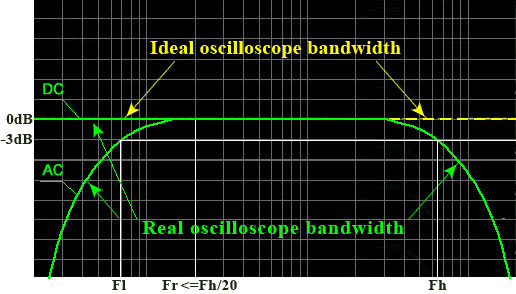| www.tmatlantic.com
Test & Soldering Equipment On-line Store |
|
D.E.V.I.C.E. (Wiki)Calculators Services |
|||||
Filter by first letter
|
BandwidthOscilloscope bandwidth is a frequency range (“Fl - Fh” in the pic.) where oscilloscope signal attenuation doesn’t exceed – 3 dB relative to reference frequency signal (“Fr” in the pic.). Reference bandwidth shouldn’t exceed 5% of bandwidth upper frequency limit. For general purpose oscilloscopes reference frequency is usually taken as 1kHz. In addition such oscilloscopes usually have “AC-DC” input mode switching capability. In DC mode bandwidth lower frequency equals 0 (Fl = 0). That allows working with low-frequency signals, to the direct current, as well as with the signals which have a constant component. Also all oscilloscopes have bandwidth limit function for the improving of signal/noise ratio during regular signals registration.
There is a certain connection between the bandwidth upper frequency and a scope rise time: Fh(MHz) = 0.35 / tr (μs) This ratio is right if the rise time is measured between 10% and 90% levels from the amplitude of rectangular test signal on the scope display. The whole device analog tract is considered equivalent to the periodical link of the first order. For general purpose oscilloscopes such conditions are usually satisfied. El ancho de banda del osciloscopio es un rango de frecuencia (“Fl - Fh” in the pic.)donde el osciloscopio signal attenuation no excede – 3 dB relativo a la señal de frecuencia de referencia (“Fr” in the pic.). El ancho de banda de referencia no debe exceder el 5% del límite de frecuencia superior del ancho de banda. Para los osciloscopios de uso general, la frecuencia de referencia suele tomarse como 1 kHz. Además, estos osciloscopios suelen tener capacidad de conmutación de modo de entrada "AC-DC". En el modo CC, la frecuencia inferior del ancho de banda es igual a 0 (Fl = 0). Eso permite trabajar con señales de baja frecuencia, a la corriente continua, así como con las señales que tienen una componente constante. También todos los osciloscopios tienen bandwidth limitfunción para mejorar la relación señal/ruido durante el registro de señales regulares.
Existe una cierta conexión entre la frecuencia superior del ancho de banda y un osciloscopio rise time: Fh(MHz) = 0.35 / tr (μs) Esta relación es correcta si el tiempo de subida se mide entre niveles del 10 % y el 90 % de la amplitud de la señal de prueba rectangular en la pantalla del osciloscopio. Todo el dispositivo de vía analógica se considera equivalente al enlace periódico de primer orden. Para los osciloscopios de uso general, tales condiciones generalmente se cumplen. |
Measurement History Events
|
Site mapPrivacy policyTerms of Use & Store PoliciesHow to BuyShippingPayment




|



























